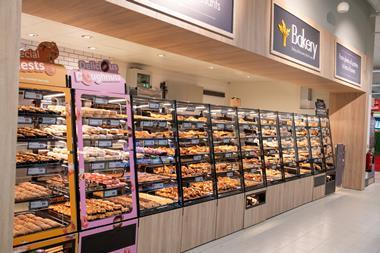Bakers are facing continued increases in wheat prices as a result of the dry weather – as butter once again heads towards record highs.
The price of bread wheat has risen sharply since Easter, with the National Association of British and Irish Flour Millers (Nabim) reporting the milling wheat premium is as much as £25 above feed wheat.
July quoted values for bread wheat in north-west England – often taken as a UK benchmark – have risen £30 since Easter to £198 at the end of June, a trend also seen nationally.
As with other wheat markets around the globe, prices are being pushed up by concerns over the impact of weather conditions on crops.
“The hot and dry weather that the UK is currently experiencing is likely to negatively affect the wheat crop,” said analyst Mintec. “Although it is too early to tell, if this dryness continues, a production fall of up to 10% could occur. Meanwhile, globally, EU endings stocks have been forecast down 20% year-on-year for 2018/19, driven by a reduced harvested area and increased exports, forecast up 21% year-on-year.”
In the UK, wheat crops on lighter, sandier, soils are suffering in the hot weather, while those on heavier soils are understood to be faring better.
“While it is too early to say what impact the dry weather will have on the quality of the wheat, if it carries on, the overall size of the crop will diminish,” said Nabim director general Alex Waugh.
As previously reported by British Baker, European crop yields have been revised downwards following unusually warm and dry weather. The average total wheat yield has dropped 2.4% since May, according to the latest EC Crop Monitoring Report.
Hot conditions and low rainfall in Germany – particularly in the north and east – have taken a toll, with yield forecast 3.3% below the five-year average. Similar conditions have been reported in areas including Austria, Czech Republic and Romania. Additionally, wet May/June weather in France (the EU’s largest exporter) has prompted concerns over low specific weights and disease.
According to United States Department of Agriculture (USDA) forecasts, the Russian crop is down 19% on last season, due to wet spring conditions.
%%Quote_30%%
European farming trade group Copa and Cogeca this week released new figures predicting a 6% drop in EU cereal and oilseeds production due to extreme weather conditions.
“Farmers in some Central European and Northern countries – Estonia, Latvia, Lithuania, Denmark, Sweden, Poland, Germany and Finland – have been hit by severe drought, which is reaching catastrophic proportions,” said Copa and Cogeca cereals working party chairman Max Schulman, adding that some southern countries had been experiencing floods.
Mintec said global wheat prices had fallen slightly from high levels, however, as much-needed rainfall in Western Australia gave relief to the Australian wheat crop.
Meanwhile, butter prices have also continued to soar. The price of a tonne of EU butter rose 12% between May and June to €5,971, which is up more than 20% on this time last year.
Butter prices have been a major concern for the industry for more than a year, with margins being squeezed after butter hit record high prices last year. Businesses including Aryzta and Finsbury Foods have said the rising cost of butter has affected profits.
Butter prices are currently being pushed up by factors including slower-than-expected growth in production in the EU. In addition, producers’ returns for butter are lower compared to cheese and whey, so demand is outweighing supply.
“These prices look set to test last year’s record highs, but only if demand is maintained as consumers may change to cheaper alternative spreads like margarine,” said analyst Mintec.



































No comments yet